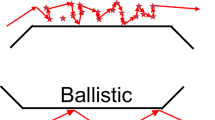Abstract
WHEN an aircraft flies at low altitude and at high speed, the terrain goes past so quickly that the pilot may be unable to see ground features clearly, particularly when he looks to either side of his aircraft. This is due to the fact that the angular velocity of the passing scene is least ahead and aft, but greatest at right angles to the line of flight. The investigation of this problem, first graphically, then by calculation, has revealed an interesting fact which may well have other applications.
This is a preview of subscription content, access via your institution
Access options
Subscribe to this journal
Receive 51 print issues and online access
$199.00 per year
only $3.90 per issue
Buy this article
- Purchase on Springer Link
- Instant access to full article PDF
Prices may be subject to local taxes which are calculated during checkout
Similar content being viewed by others
References
Crawford, W. A., Flying Personnel Research Committee Memorandum, 150(a).
Miller, J. W.,and Ludvigh, E. J., Survey of Ophthalmology, 7, 83 (1962).
Goodson, J. E., and Miller, J. W., Kresge Eye Institute and US Naval School of Aviation Medicine Joint Project, NM-17.01. 99, Sub-task 2, 16 (1959).
Author information
Authors and Affiliations
Rights and permissions
About this article
Cite this article
WHITESIDE, T., SAMUEL, G. Blur Zone. Nature 225, 94–95 (1970). https://doi.org/10.1038/225094a0
Received:
Revised:
Issue Date:
DOI: https://doi.org/10.1038/225094a0
This article is cited by
-
Vision-based control of near-obstacle flight
Autonomous Robots (2009)
-
An active method of extracting egomotion parameters from optical flow
Biological Cybernetics (1985)
-
Egomotion and relative depth map from optical flow
Biological Cybernetics (1980)
Comments
By submitting a comment you agree to abide by our Terms and Community Guidelines. If you find something abusive or that does not comply with our terms or guidelines please flag it as inappropriate.



